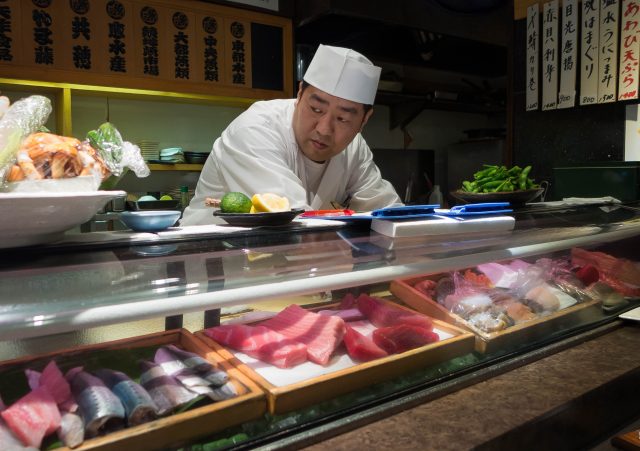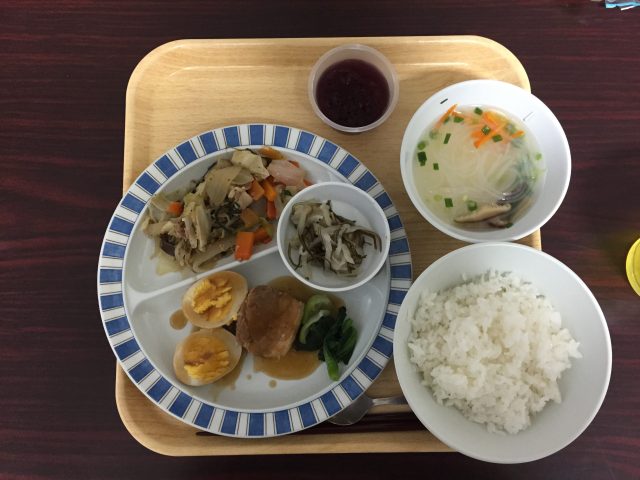The self-proclaimed aficionado parked at the sushi bar adds more wasabi to his little soya sauce bowl turning the mixture into sickly green mud. He then drops a piece of sushi in the mixture. The delicately molded rice brakes apart as the rice soak up more and more of the sauce. The sushi chef, neck veins twitching, his expression frozen in an impossible display of self-control, watches his guest with a smile. Sushi and other imported Japanese foods have gained much popularity in recent years. Discovering new food horizons is more than just sampling the exotic, it is also respecting the etiquette around which it developed. The best strategy to do so is to quietly observe Japanese people around the table learning from your own mistakes. When in Rome… The following pointers might not save you from offending a Japanese host but it will help you become more familiar with Japanse table manners.
Mastering chopsticks

I am never sure how to react when Japanese people tell me that “I am so good with chopsticks.” Is it an innocent compliment? Are they genuinely impressed that someone not Japanese could use such tricky sticks? Or perhaps these are just words of encouragement for a struggling novice? When using chopsticks, certain basic rules of politeness apply. Do not hand over food with chopsticks. Do not stick your chopstick vertically in a bowl of rice. Both are only used in funeral practices. Beyond the obvious morbid taboos, particular manners will also be expected of you when you use these utensils. You should rest chopsticks on a chopstick rest (hashioki). Chopsticks should not be crossed, left on the rim of a bowl or generally thrown around in an untidy manner. One should never stab the food with a chopstick nor lick sauce off them. Finally, previously used chopsticks should not be used on a common plate even if inverted as your mouth or fingers should not have touched the other end of the utensil.
Eating Japanese rice
The first time I was invited to eat in a Japanese home, I was handed a bowl of white rice. Not understanding how to eat the plain white rice, I asked if I could have some soya sauce with it. My hosts laughed and told me one did not mix Japanese rice with soya sauce. In Japan, rice is the centerpiece of the meal. It should be eaten unblemished with no sauce. Instead, one should appreciate the delicate flavor of Japanese rice in tandem with the various side dishes. A bite of fish, a pickle or a sip of miso soup should be accompanied with a mouthful of rice. Rice is the staple of the Japanese diet and a symbol of Japanese culture. It should be treated with respect making sure the last grain is scraped out of the bowl. Something that is more easily said than done for the inexperienced chopstick user.

So many different bowls
Bowls in Japanese tableware come in all shapes and sizes. Rice bowls, miso soup bowls, donburi bowls, noodle soup bowls are specifically shaped for different dishes. For example, a miso soup bowl is not used with a spoon but instead is brought to the mouth in order to drink its content. Larger donburi bowls, rice topped with fish or meat, are typically eaten with a spoon. Holding the bowl in one’s hand is perfectly acceptable as ceramic and lacquer bowls insulate the heat unlike a Korean metal rice bowl, which is considered rude to hold up as it might burn one’s hand. Eating from a bowl using chopsticks requires some practice and dexterity as grains or rice are not easily picked up this way. Although it might appear that Japanese people “shovel” food from the bowl to the mouth, it is considered rude to eat in such a way. When done with a lidded bowl, it is good manners to put the lid back on the bowl.

Making sounds at the table
As I explain all the intricacies of my research in Japan, my Japanese host became slightly annoyed. “Why do you talk so much and not eat,” he says to me. Unlike France where I grew up, conversation and noises are frowned upon during meals in Japan. Dinner is for eating rather than socializing. During school lunches, Japanese students are not allowed to speak until they are finished eating. The teachers explain that students would not finish their food otherwise. In Japan, manners are taught as much in school as at home. For this reason, students must understand that one should not talk during a meal. Belching, chewing loudly and blowing one’s nose are unsurprisingly considered rude at the dinner table. The one exception is that it is allowed, if not encouraged, to slurp noodles from a soup bowl. On one hand, it shows appreciation for the food. On the other hand, it enables to quickly cool down noodles that are too hot to eat.

When talking is permissible
Itadakimasu and gochisosama, phrases that are said to give thanks before and after a meal, are often the only words uttered in most Japanese meals. Meals are typically eaten without talking only with the sound of chopsticks clinging against bowls. Although family meals are eaten in this manner, special occasions are well-lubricated and boisterous events. In Japan, as in other places around the world, alcohol is used to facilitate verbal communication (nominication). Meals in Japanese drinking taverns (izakaya) or traditional banquets (enkai) always include alcohol consumption. Whereas typical family meals in Japan are quiet, these events are loud rambunctious affairs where talking is not only tolerated, it is required. As people go around sharing and pouring drinks for each other, conversations are created around the dinner table. Drinking excesses and infringements of social norms are expected in order to give people a platform for self-expression. No one will ever dare mention to you these infringements, even sometimes feigning to have forgotten them, yet, one must be aware that the way you behave at those drinking parties will be seen as a mark of character.


